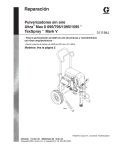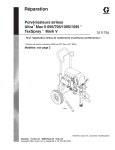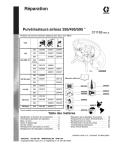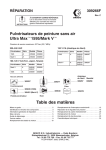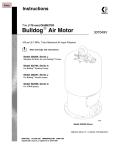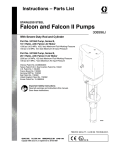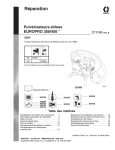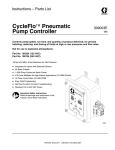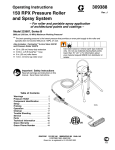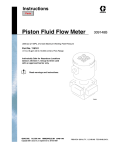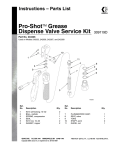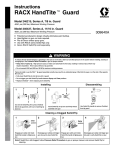Download Graco 309941J User's Manual
Transcript
Repair Ultrar Max II 695/795/1095/1595t TexSprayt Mark V Airless Sprayers 309941J – For Portable Airless Spraying of Architectural Coatings and Paints – 3300 psi (227 bar, 22.7 MPa) Maximum Working Pressure Models: See page 2 ti4281a GRACO INC.ąP.O. BOX 1441ąMINNEAPOLIS, MNą55440-1441 Copyright 2004, Graco Inc. is registered to I.S. EN ISO 9001 Table of Contents Component Function and Identification . . . . . 4 General Repair Information . . . . . . . . . . . . . . . 5 Grounding . . . . . . . . . . . . . . . . . . . . . . . . . . . . . . 5 Troubleshooting . . . . . . . . . . . . . . . . . . . . . . . . . 6 Mechanical/Fluid Flow . . . . . . . . . . . . . . . . 6 Electrical . . . . . . . . . . . . . . . . . . . . . . . . . . . . 7 Pressure Control Repair . . . . . . . . . . . . . . . . 10 Drive and Bearing Housing Replacement . . Motor Replacement . . . . . . . . . . . . . . . . . . . . . Displacement Pump Replacement . . . . . . . . Technical Data . . . . . . . . . . . . . . . . . . . . . . . . . Dimensions . . . . . . . . . . . . . . . . . . . . . . . . . . . . Graco Standard Warranty . . . . . . . . . . . . . . . Models Vac 120 Model Type Lo-Boy Hi-Boy 695 Standard 248037 248036 Premium 248031 248030 Standard 248308 248038 Premium 248033 248032 795 North America 1095 1595 R Standard 248039 Premium 248034 Standard 248747 248040** Premium 248746 248035** Mark V 249029** 249030 ti4281a 240 695 248042 Europe 795 248043 1095 248044 Mark V 249031 248046 240 695 Europe Multi-cord 795 248047 1095 248048 Mark V* 249178 110 695 248049 UK 795 248050 1095 248051 Mark V 249072 248058 695 Asia 795 248059 1095 248060 248057 240 695 248593 248592 Australia 795 249431 248594 248595 100 695 248053 248052 Japan & Taiwan 795 248055 248054 1095 * Also for Asia and Australia; Not ETL Approved All models not available in all countries. ** 309941 Hi-Boy 248045 240 1095 2 248041 248056 ti4278a Lo-Boy 16 18 20 21 21 22 WARNING FIRE AND EXPLOSION HAZARD Flammable fumes, such as solvent and paint fumes, in work area can ignite or explode. To help prevent fire and explosion: D Use equipment only in well ventilated area. D Eliminate all ignition sources; such as pilot lights, cigarettes, portable electric lamps, and plastic drop cloths (potential static arc). D Keep work area free of debris, including solvent, rags and gasoline. D Do not plug or unplug power cords or turn lights on or off when flammable fumes are present. D Ground equipment and conductive objects in work area. See Grounding instructions. D Use only conductive hoses. D Hold gun firmly to side of grounded pail when triggering into pail. D If there is static sparking or you feel a shock, stop operation immediately. Do not use equipment until you identify and correct the problem. INJECTION HAZARD High–pressure fluid from gun, hose leaks, or ruptured components will pierce skin. This may look like just a cut, but it is a serious injury that can result in amputation. Get immediate medical attention. D Do not point the gun at anyone or at any part of the body. D Do not put your hand over the spray tip. D Do not stop or deflect leaks with your hand, body, glove or rag. D Do not spray without tip guard and trigger guard installed. D Engage trigger lock when not spraying. D Follow the Pressure Relief Procedure on page 5 if the spray tip clogs and before cleaning, checking or servicing the equipment. ELECTRIC SHOCK HAZARD Improper grounding, setup or usage of the system can cause electric shock. D Turn off and disconnect power cord before servicing equipment. Wait 5 minutes after disconnecting from power source before servicing motor control. D Use only grounded electrical outlets. D Use only 3-wire extension cords. D Ensure ground prongs are intact on sprayer and extension cords. PERSONAL PROTECTIVE EQUIPMENT You must wear appropriate protective equipment when operating, servicing, or when in the operating area of the equipment to help protect you from serious injury, including eye injury, inhalation of toxic fumes, burns, and hearing loss. This equipment includes but is not limited to: D Protective eyewear D Clothing and respirator as recommended by the fluid and solvent manufacturer D Gloves D Hearing protection PRESSURIZED ALUMINUM PARTS HAZARD Do not use 1,1,1–trichloroethane, methylene chloride, other halogenated hydrocarbon solvents or fluids containing such solvents in pressurized aluminum equipment. Such use can cause serious chemical reaction and equipment rupture, and result in death, serious injury, and property damage. 309941 3 Component Identification and Function G A B R P S V ti2377a J K H T N F E W M ti4281a U D Fig. 1 4 A Motor DC motor, permanent magnet, totally enclosed, fan cooled B Drive Assembly Transfers power from DC motor to displacement pump D Displacement Pump Transfers fluid to be sprayed from source through spray gun E Fluid Outlet Fluid hose is connected here F Prime Valve Used to prime and drain sprayer (also relieves fluid outlet pressure) when open G Fluid Filter Final filter of fluid to spray gun H Pressure Control Knob Controls fluid outlet pressure J Pressure Control Controls motor speed to maintain fluid outlet pressure at displacement pump outlet. Works with pressure adjusting knob. K ON/OFF Switch Power switch that controls main power to sprayer M 50 ft (15 m) Main Hose 1/4 in. ID, grounded, nylon hose with spring guards on both ends N Spray Gun High pressure spray gun with gun safety latch P Spray Tip Uses high pressure fluid to clear tip clogs without removing tip from spray gun R HandTitet Tip Guard Tip guard reduces risk of injection injury S Gun Safety Latch Gun safety latch inhibits accidental triggering of spray gun. Contractor II gun shown. Refer to your gun manual to properly set your gun safety latch. T Hose Rack Holds wrapped hose for storage U Suction Tube Transfers fluid to be sprayed from source to pump V Drain Tube Fluid outlet used to drain and prime the sprayer W AutoClean Reverse flush system 309941 General Repair Information Pressure Relief Procedure CAUTION To reduce risk of pressure control malfunction: WARNING INJECTION HAZARD System pressure must be manually relieved to prevent system from starting or spraying accidentally. Fluid under high pressure can be injected through skin and cause serious injury. To reduce risk of injury from injection, splashing fluid, or moving parts, follow Pressure Relief Procedure whenever you: D D D D are instructed to relieve pressure, stop spraying, check or service any system equipment, or install or clean spray tip. D Use needle nose pliers to disconnect wire. Never pull on wire, pull on connector. D Mate wire connectors properly. Center flat blade of insulated male connector in female connector. D Route wires carefully to avoid interference with other connections of pressure control. Do not pinch wires between cover and control box. 1. Keep all screws, nuts, washers, gaskets, and electrical fittings removed during repair procedures. These parts are not normally provided with replacement assemblies. WARNING ELECTRIC SHOCK HAZARD MOVING PARTS HAZARD HOT SURFACE HAZARD To reduce risk of serious injury, including electric shock, do not touch moving or electrical parts with fingers or tools while testing repair. Shut off and unplug sprayer when inspection is complete. Install all covers, guards, gaskets, screws, washers and shroud before operating sprayer. 1. Turn pressure control knob to zero. 2. Turn ON/OFF switch to OFF. 3. Unplug power supply cord. 4. Hold metal part of gun firmly to grounded metal pail. Trigger gun to relieve pressure. 5. Lock gun safety latch. 6. Open prime valve. Leave prime valve open until ready to spray again. If suspected that spray tip or hose is completely clogged, or that pressure has not been fully relieved after following steps above, VERY SLOWLY loosen tip guard retaining nut or hose end coupling to relieve pressure gradually, then loosen completely. Now clear tip or hose obstruction. 2. Test repair after problem is corrected. 3. If sprayer does not operate properly, review repair procedure to verify procedure was done correctly. If necessary, see Troubleshooting, pages 6 – 9, for other possible solutions. Grounding WARNING Improper installation or alteration of grounding plug results in risk of electric shock, fire or explosion that could cause serious injury or death. 1. Fig. 2. Ultra Max II 695, 795 and 1095 100–120 Vac models require a 50/60 Hz, 15A circuit with a grounding receptacle. Ultra Max II 1595 120 Vac models require a 50/60 Hz 20A circuit with a grounding receptacle; 220–240 Vac models require a 50/60 Hz, 10A circuit with a grounding receptacle. 2. Do not alter ground prong or use adapter. Grounding Plug Grounded Outlets Fig. 2 3. 120 Vac: A 12 AWG, 3 wires with grounding prong, 300 ft (90 m) extension cord may be used. 220–240 Vac: You may use a 3-wire, 1.0 mm (12 AWG) (minimum) extension cord up to 90 m long. Long lengths reduce sprayer performance. 309941 5 Troubleshooting Relieve pressure; page 5. Mechanical/Fluid Flow TYPE OF PROBLEM WHAT TO CHECK If check is OK, go to next check WHAT TO DO When check is not OK refer to this column Low or No Fluid/Pressure Output 1. Spray tip worn 1. Follow Pressure Relief Procedure Warning, then replace tip. See your separate gun or tip manual. 2. Spray tip clogged 2. Relieve pressure. Check and clean spray tip. 3. Paint supply 3. Refill and reprime pump 4. Intake strainer clogged 4. Remove and clean, then reinstall 5. Intake valve ball and piston ball are not seating 5. Remove intake valve and clean. Check properly balls and seats for nicks; replace if necessary, page 20. Strain paint before using to remove particles that could clog pump. 6. Suction hose connections 6. Tighten any loose connections. Check for missing or damaged seals. 7. Filter clogged 7. Relieve pressure. Check and clean filter. 8. Prime valve leaking 8. Relieve pressure. Repair prime valve. 9. Verify pump does not continue to stroke when 9. Service pump. See page 20. gun trigger is released. (Prime valve not leaking.) 10. Leaking around throat packing nut which may 10.Replace packings, page 20. Also check indicate worn or damaged packings. See page piston valve seat for hardened paint or 20. nicks and replace if necessary. Tighten packing nut/wet-cup. 11. Pump rod damage 11. Repair pump, page 20 12.Low stall pressure 12. Do either or both: a. Turn pressure control knob fully clockwise. Make sure pressure control knob is properly installed to allow full clockwise position. b. Try a new pressure transducer. Motor runs but pump does not 1. Displacement pump pin (32) damaged or miss- 1. Replace pump pin if missing. Be sure reing, page 20 tainer spring (31) is fully in groove all stroke around connecting rod, page 20. 6 309941 2. Connecting rod assembly (43) damaged, page 16 2. Replace connecting rod assembly, page 16 3. Gears or drive housing damaged, page 16 3. Inspect drive housing assembly and gears for damage and replace if necessary, page 16 Troubleshooting Electrical Symptom: Sprayer does not run or stops running D Relieve pressure; page 5. D Plug sprayer into correct voltage, grounded outlet D Set power switch OFF for 30 seconds and then ON again. This ensures sprayer is in normal run mode. D Turn pressure control knob clockwise 1/2 turn. D View digital display WARNING To avoid electrical shock or moving parts hazards when covers are removed for troubleshooting, wait 30 seconds after unplugging power cord for stored electricity to dissipate. Keep clear of electrical and moving parts during troubleshooting procedures. D If no digital display is available, use control board status light to troubleshoot problems: Turn ON/OFF switch OFF, remove control cover and then turn power back ON. Observe status light. CONTROL BOARD STATUS LIGHT INDICATION WHAT TO DO Blank Never lights No power to control board 1. Verify required voltage is present LED 100 DIGITAL DISPLAY 2. Check wiring connections to control board 3. Perform continuity check on power cord and switch. Replace power cord or switch as needed. 4. If steps 1 – 3 are ok, replace control board –––– psi Blinks once and stops No RUN command to control board. 1. Make sure prime valve is open and there is no pressure in the system 2. Turn pressure control knob clockwise 3. Check potentiometer connection to control board 4. Check pressure control knob alignment to potentiometer shaft. Turn shaft fully clockwise and attach knob in full ON position. 5. Unplug potentiometer. Short out center pin of control board potentiometer connector to each outer pin (one at a time). If sprayer runs, replace potentiometer, page 15. 6. Check transducer connection 7. Disconnect and reconnect transducer plug to ensure good connection with control board socket. Check that transducer contacts are clean. 8. Open prime valve. Connect a known good transducer in place of the sprayer transducer. Set sprayer ON. Replace transducer If sprayer runs. Replace control board If sprayer does not run. 309941 7 Troubleshooting Electrical DIGITAL DISPLAY Displays high pressure when prime valve is open and there is no pressure in sprayer. CONTROL BOARD STATUS LIGHT – Blinks 2 x repeatedly E=02 INDICATION Improper pressure signal to control Control board is receiving excessive pressure signal from transducer. Transducer may be damaged or fluid flow path may be clogged. WHAT TO DO Open prime valve. Connect a known good transducer in place of the sprayer transducer. Set sprayer ON. Replace transducer If sprayer runs. Replace control board If sprayer does not run. 1. Check fluid path for clogs, such as a clogged filter. 2. Open prime valve and gun if running AutoClean 3. Use airless paint spray hose with no metal braid, 1/4 in. x 50 ft minimum. Smaller hose or metal braid hose may result in high-pressure spikes. 4. Replace transducer if fluid path is not clogged and proper hose is used Blinks 3 x repeatedly E=03 Transducer or transducer connection error 1. Check transducer connection 2. Disconnect and reconnect transducer plug to ensure good connection with control board socket. Check that transducer contacts are ok. 3. Open prime valve. Connect a known good transducer in place of the sprayer transducer. Set sprayer ON. Replace transducer If sprayer runs. Replace control board If sprayer does not run. 8 309941 Troubleshooting Electrical DIGITAL DISPLAY CONTROL BOARD STATUS LIGHT INDICATION WHAT TO DO E=05 Blinks 5 x repeatedly Possible locked pump or drive. May be motor connection or wiring error. 1. Check motor wiring connections 2. Check for locked or frozen pump or drive train 3. If all motor wiring connections are OK and pump/ drive train are not locked up, replace motor E=06 E=07 Blinks 6 x repeatedly Blinks 7 x repeatedly Motor is too hot or motor/thermal device connection may be bad. Exceeded 2000 psi during timed flush cycle 1. Check all wire connections from motor to control board 2. If connections are all ok, allow sprayer to cool. If sprayer runs when cool, correct cause of overheating. Keep sprayer in cooler location with good ventilation. Make sure motor air intake is not blocked. This error only occurs in flush timer mode 1. Make sure prime valve and gun are open 2. Make sure no flow obstructions or clogged filter E=09 Blinks 9 x repeatedly Motor sensor failure E=10 Blinks 10 x repeatedly High control board temperature Make sure motor sensor (resolver) is connected to the control board and check wiring for damage 1. Make sure the motor air intake is not blocked 2. Make sure control board is properly connected to the back plate and that conductive thermal paste is used on the power components, Fig. 3 E=11 Blinks 11 x repeatedly Excessive motor speed E=12 Blinks 12 x repeatedly High Current Check for damaged gears or disconnected pump 1. Check for locked or frozen pump or drive train 2. Check for possible short circuits in wiring 3. Check pressure output and replace transducer if pressure is excessive E=13 EMPTY Blinks 13 x repeatedly – Model not selected Control board identity resistors must be properly clipped to identify model type, manual 310657 EMPTY on digital display indicates a loss of paint to the pump or a severe loss in pressure 1. Check for empty paint condition, clogged inlet strainer, failed pump or severe leak. Turn pressure control knob to zero to restart sprayer. 2. WatchDog (W-DOG) feature can be deactivated. See Operation Manual 309935. 309941 9 Pressure Control Repair 100 – 120 Vac North American and Japan/Taiwan Motor Control Board Removal Installation 1. Fig. 3. Apply small amount of thermal compound 110009 (5) to shaded component areas on rear of motor control board (95). Relieve pressure; page 5. Wait 5 minutes before servicing. 1. CAUTION 2. Fig. 3. Remove four screws (38) and cover (96). 3. Disconnect display connector (A) from motor control board (95). To reduce risk of motor control board failure, do not overtighten screws (102) which can damage the electric components. 4. Remove bottom two screws (39) and allow control panel (68) to hang down freely. 2. Install motor control board (95) with five screws (27). Torque to 9–11 in-lb (1.02 – 1.24 N·m). Install and torque three screws (102) to values in Fig 3. 3. Connect motor connectors (F, G and H) to motor control board. 4. Install control box (61) with top two screws (39). 5. Connect transducer connector (E) to motor control board. 6. Connect 15/20A switch (178) (1595). 7. Connect motor control board power lead(s) (D) to ON/OFF switch (33). 8. Connect potentiometer connector (C) to motor control board. 9. Install control panel (68) with two screws (39) . 10. Connect display connector (A) to motor control board. 11. Install cover (96) with four screws (38). 5. Disconnect control board power lead(s) (D) from ON/OFF switch (33) and motor control board (95). 6. Disconnect potentiometer connector (C) from motor control board. 7. Disconnect 15/20A switch (178) (1595). 8. Disconnect transducer connector (E) from motor control board. 9. Disconnect motor connectors (F, G and H) from motor control board. 10. Remove top two screws (39) and control box (61). 11. Remove five screws (27), three screws (102) and motor control board. 5 100 – 120 Vac North American and Japan/Taiwan Tighten 1 screw to 14–17 in–lb 95 26 61 A F C G A 96 95 27 40 38 33 D Tighten 2 screws to 7–10 in–lb E 39 80 C 1 178 68 Fig. 3 309941 39 115 34 ti4289b 20 67 82 10 B H 102 E 1 1595 240 Vac Motor Control Board Removal 1. Relieve pressure; page 5. Wait 5 minutes before servicing. Installation 1. Fig. 4. Apply small amount of thermal compound 110009 (5) to shaded areas on rear of motor control board (95). 2. Fig. 4. Remove four screws (38) and cover (96). 3. Disconnect display connector (A) from motor control board (95). 4. Remove bottom two screws (39). Disconnect potentiometer connector (C) from motor control board (95). Disconnect power cord connectors (D) and filter board connectors (J) from ON/OFF switch (33) and remove control panel (68). 5. Disconnect motor control board power connectors (K) from filter board (146). 6. Remove top two screws (39) and control box (61). 7. Disconnect transducer connector (E) from motor control board. 8. Disconnect motor connectors (F, G and H) from motor control board. 9. Remove five screws (27), three screws (102) and motor control board. CAUTION To reduce risk of motor control board failure, do not overtighten screws (102) which can damage the electric components. 2. Install motor control board (95) with five screws (27). Torque to 9–11 in-lb (1.02 – 1.24 N·m). Install and torque three screws (102) to values shown in Fig 5. 3. Connect motor connectors (F, G and H) to motor control board. 4. Connect transducer connector (E) to motor control board. 5. Connect motor control board power connectors (K) to filter board (146). 6. Install control box (61) with top two screws (39). 7. Connect filter board power connectors (J) and power cord connectors (D) to ON/OFF switch (33). 8. Connect potentiometer connector (C) to motor control board. 9. Install control panel (68) with two screws (39) . 10. Connect display connector (A) to motor control board (95). 11. Install cover (96) with four screws (38). 240 Vac Filter Board Removal 1. Relieve pressure; page 5. Wait 5 minutes before servicing. 2. Fig. 4. Remove four screws (38) and cover (96). 3. Disconnect display connector (A) from motor control board (95). 4. Remove bottom two screws (39). Disconnect potentiometer connector (C) from motor control board (95). Disconnect power cord connectors (D) and filter board connectors (J) from ON/OFF switch (33) and remove control panel (68). Installation 1. Fig. 4. Install filter board (146) with four screws (163). 2. Connect motor control board power connectors (K) to filter board (146). 3. Connect filter board power connectors (J) to top two terminals of ON/OFF switch (33) and power cord connectors (D) to bottom two terminals of ON/OFF switch. 4. Connect potentiometer connector (C) to motor control board (95). 5. Install control panel (68) with two screws (39). 5. Disconnect motor control board power connectors (K) from filter board (146). 6. Connect display connector (A) to motor control board (95). 6. Remove four screws (163) from filter board (146). 7. Install cover (96) with four screws (38). 309941 11 5 240 Vac 95 Tighten 1 screw to 14–17 in-lb (1.58–1.92 NSm) 26 K 61 146 163 A F C G A 96 B H 102 E 95 38 33 J A 27 A Tighten 2 screws 7–10 in–lb (.79–1.13 NSm) 39 D E C 80 ti4345a 20 68 39 67 82 34 Fig. 4 12 309941 115 110 Vac U.K. Motor Control Board Removal 1. Relieve pressure; page 5. Wait 5 minutes before servicing. Installation 1. Fig. 5. Apply small amount of thermal compound 110009 (5) to shaded areas on rear of motor control board (95). 2. Fig. 5. Remove four screws (38) and cover (96). 3. Disconnect display connector (A) from motor control board (95). 4. Remove bottom two screws (39). Disconnect potentiometer connector (C) from motor control board (95). Disconnect filter board connector (J) and power cord connector (D) from ON/OFF switch (33). Remove control panel (68). 5. Disconnect motor control board power connectors (K) from filter board (146). Disconnect filter connector (L) from power cord connector (L). 6. Remove top two screws (39) and control box (61). 7. Disconnect transducer connector (E) from motor control board. 8. Disconnect motor connectors (F, G and H) from motor control board. 9. Remove five screws (27), three screws (102) and motor control board. CAUTION To reduce risk of motor control board failure, do not overtighten screws (102) which can damage the electric components. 2. Install motor control board (95) with five screws (27). Torque to 9–11 in-lb (1.02 – 1.24 N·m). Install and torque three screws (102) to values shown in Fig 5. 3. Connect motor connectors (F, G and H) to motor control board. 4. Connect transducer connector (E) to motor control board. 5. Connect motor control board power connectors (K) to filter board (146). Connect filter connector (L) to power cord connector (L). 6. Install control box (61) with top two screws (39). 7. Fig. 5. Connect filter board power connector (J) and power cord connector (D) to ON/OFF switch (33). 8. Connect potentiometer connector (C) to motor control board. 9. Install control panel (68) with two screws (39) . 10. Connect display connector (A) to motor control board (95). 11. Install cover (96) with four screws (38). 110 Vac U.K. Filter Board Removal 1. Relieve pressure; page 5. Wait 5 minutes before servicing. Installation 1. Fig. 5. Connect motor control board power connectors (K) to filter board (146). Connect filter connector (L) to power cord connector (L). 2. Fig. 5. Remove four screws (38) and cover (96). 2. Install filter board (146) with four screws (163). 3. Disconnect display connector (A) from motor control board (95). 3. Fig. 5. Connect filter board power connector (J) and power cord connector (D) to ON/OFF switch (33). 4. Remove bottom two screws (39). Disconnect potentiometer connector (C) from motor control board (95). Disconnect filter board connector (J) and power cord connector (D) from ON/OFF switch (33). Remove control panel (68). 4. Connect potentiometer connector (C) to motor control board (95). 5. Install control panel (68) with two screws (39). 5. Disconnect motor control board power connectors (K) from filter board (146). Disconnect filter connector (L) from power cord connector (L). 6. Connect display connector (A) to motor control board (95). 6. Remove four screws (163) from filter board (146). 7. Install cover (96) with four screws (38). 309941 13 5 110 Vac U.K. 95 Tighten 1 screw to 14–17 in lb (1.58–1.92 NSm) 26 K 61 146 163 A F C G A 96 B H 102 E 95 38 33 J A 27 A L Tighten 2 screws 7–10 in–lb (.79–1.13 NSm) 39 D E C 80 ti5015a 20 68 39 67 82 34 Fig. 5 14 309941 115 Pressure Adjust Potentiometer Removal 1. Installation Relieve pressure; page 5. Wait 5 minutes before servicing. 2. Fig. 3, 4 or 5. Remove four screws (38) and cover (96). 3. Disconnect potentiometer connector (C) from motor control board (95). 4. Remove pressure control knob (34) with a hex wrench. 5. Remove gasket (115), nut and potentiometer (82) from control panel (68). 1. Install gasket (115), nut and potentiometer (82) on control panel (68). Torque nut to 30–35 in-lb (3.38–3.95 N·m). 2. Install pressure control knob (34): Check pressure control knob alignment to potentiometer shaft. Turn shaft fully clockwise and attach knob in full ON position with a hex wrench. 3. Connect potentiometer connector (C) to motor control board. 4. Install cover (96) with four screws (38). Pressure Control Transducer Removal 1. 7. Remove grommet (40) from transducer and save for reuse. Relieve pressure; page 5. Wait 5 minutes before servicing. 2. Fig. 3 or 5. Remove four screws (38) and cover (96). 3. Disconnect transducer connector (E) from motor control board (95). 4. Disconnect potentiometer connector (C) from motor control board. 5. Remove four screws (39) and control box (61). Allow control panel to hang down freely. 6. Remove transducer (86) and o-ring (20) from filter base (67). Installation 1. Install o-ring (20) and transducer (86) in filter base (67). Torque to 35–45 ft-lb (47–61 N·m). 2. Install grommet (40) onto transducer (86). 3. Connect transducer connector (E) to motor control board. 4. Install control box (61) and control panel (68) with four screws (39). 5. Connect potentiometer connector (C) to motor control board. 6. Install cover (96) with four screws (38). 309941 15 Drive and Bearing Housing Replacement CAUTION Do not drop gear cluster (89) when removing drive housing (90). Gear cluster may stay engaged in motor front end bell or drive housing. Disassembly 1. Relieve pressure; page 5. 2. Remove screw (31), two nuts (24), pail hanger (55) and pump rod cover (108). 7. Remove five screws (6) and pull drive housing (90) off motor (84). Assembly Fig. 7. Make sure gear (89) and thrust washers (28, 30, 90a, 36) are in place. Brush grease onto gear teeth. 1. Fig. 6. Push drive housing (90) onto motor (84) and install with five screws (6). Torque to 190–210 in-lb (21–23 N·m). 2. Install bearing housing (83) with four screws (14) and washers (12). Torque to 25–30 ft-lb (34–40 N·m). 3. Remove pump (91); Displacement Pump Re3. Install front cover (51) with four screws (31). placement, page 20. 4. Install shroud (72) with two screws (31). 4. Fig. 6. Remove two screws (158) and shroud (72). 5. Install pump (41); Displacement Pump Replace5. Remove four screws (158) and front cover (51). 6. Remove four screws (14) and washers (12) to remove bearing housing (83) and connecting rod (85). 16 309941 ment, page 20. 6. Install pump rod cover (108) and pail hanger (55) with screw (31) and two nuts (24). 157 72 84 158 90 51 158 6 157 ti4253a 85 24 44 43 12 14 31 55 56 Fig. 6 108 309941 17 Motor Replacement Removal Installation Relieve pressure; page 5. Wait 5 minutes before servicing. 1. 1. Slide new motor (84) under two screws (23) in cart frame (62) near control. 2. Remove pump (91); Displacement Pump Replacement, page 20. CAUTION Do not drop gear cluster (89) when removing drive housing (90). Gear cluster may stay engaged in motor front end bell or drive housing. 2. Install two screws (23) and nuts (19) on motor side opposite control. 3. Tighten all four screws (23) and nuts (19). Torque nuts to 115–135 in-lb (13–15 N·m). 4. Install strain relief (29) onto motor wires and into power bar plate (69). 3. Remove drive housing (89); Drive Housing Replacement, page 16. 4. Fig. 7. Remove four screws (38) and control cover (96). 5. Install control housing (61) with top two screws (39). 5. Remove bottom two screws (39) and and allow control panel (68) to hang down freely. 6. Connect all three motor connectors to motor control board (95). 6. Disconnect all three motor connectors from motor control board (95). 7. Install control panel (68) with two screws (39). 7. Remove top two screws (39) and control housing (61). 8. Install control cover (96) with four screws (38). 8. Remove strain relief (29) from motor wires and power bar plate (69). 9. Remove two screws (23) and nuts (19) on side opposite control. 10. Loosen two nuts (19) on side near control and remove motor (84) from cart frame (62). 18 309941 9. Install drive housing (42); Drive Housing Replacement, page 16. 10. Install pump (13); Displacement Pump Replacement, page 20. 158 157 58 (A) 795 23 84 36 19 61 90A 51 157 158 28 90 96 38 89 30 6 12 68 14 39 31 ti4254a 29 27 69 23 19 LED Status Light 95 Fig. 7 309941 19 Displacement Pump Replacement See manual 310643 for pump repair instructions. See manual 309943, 309944 or 309951 – 309954 for applicable sprayer part number references. Removal 1. Flush pump (13). 2. 4. Fig. 10. Cycle pump in JOG mode until pump pin (44) is in position to be removed. Turn power switch OFF and unplug power cord. Push up retaining ring (43) and push pump pin out. Relieve pressure; page 5. 5. Fig. 9. Remove suction tube (76), hose (94) and any washers and o-rings. 3. Fig. 8. Remove screw (31) and slide pump rod shield (108) forward. 6. Loosen pump jam nut (56). Unscrew pump. 94 ti4258a 56 76 108 Fig. 8 31 ti4258a Fig. 9 Installation 4. Screw in pump until threads are flush with drive housing opening. Align pump outlet to back. WARNING If pump pin works loose, parts could break off due to force of pumping action. Parts could project through the air and result in serious injury or property damage. CAUTION 5. Fig. 9. Install washers, o-rings and suction tube (76) and hose (94). 6. Fig. 11. Screw jam nut (56) up onto pump until nut stops. Tighten jam nut by hand, then tap 1/8 to 1/4 turn with a 20 oz (maximum) hammer to approximately 75" 5 ft–lb (102 Nm). If the pump jam nut loosens during operation, the threads of the drive housing will be damaged. 1. Fig. 10. Extend pump piston rod 1.5 in. Apply grease to top of pump rod at (A) or inside connecting rod. Fig. 11 44 1.5 in. 7. Fig. 8. Install pump rod shield (108) with screw (31). A 8. Fig. 12. Fill packing nut with Graco TSL until fluid flows onto top of seal. 43 Fig. 10 ti4258a 2. Install pump pin (44). Verify retaining spring (43) is in groove of connecting rod (85). 3. Push pump up until pump threads engage. 20 309941 ti4258a Fig. 12 Technical Data Model 100–120V, 220–240V, Generator Motor HP (W) A, Hz ∅, A, Hz Minimum W Cycles per gallon (liter) Maximum Delivery gpm (lpm) Maximum Tip size Fluid Outlet npsm 1 Gun 2 Guns 695 14, 50/60 9, 50/60 5000 1.75 (1300) 243 (64) 0.75 (2.8) 0.027 N/A 1/4 in. 795 15, 50/60 10, 50/60 5000 2.00 (1490) 195 (52) 0.95 (3.6) 0.031 0.021 1/4 in 1095 15, 50/60 10, 50/60 5000 2.20 (1640) 123 (33) 1.1 (4.1) 0.033 0.023 1/4 in Mark V N/A 10, 50/60 5000 2.20 (1640) 110 (29) 1.2 (4.3) 0.035 0.023 3/8 in 1595 20/15, 50/60 N/A 5000 2.5 (1860) 110 (29) 1.25 (4.7) 0.037 0.025 1/4 in Mark V 20/15, 50/60 N/A 5000 2.5 (1860) 110 (29) 1.25 (4.7) 0.037 0.025 3/8 in Basic Sprayer Wetted Parts: . . . . . . . . . . . . . . . . . . . . . . . . . . . . zinc- and nickel-plated carbon steel, nylon, stainless steel, PTFE, Acetel, leather, UHMWPE, aluminum, tungsten carbide, PEEK, brass Noise Level Sound power . . . . . . . . . . . . . . . . . . . . . . . . . 91 dBa* Sound pressure . . . . . . . . . . . . . . . . . . . . . . . 82 dBa* * per ISO 3744; measured at 3.1 feet (1 m) Dimensions Model Weight lb (kg) Lo-Boy Height in. (cm) Hi-boy Lo-Boy Hi-Boy Length in. (cm) in Width in. (cm) in 695 94 (43) 94 (43) 26.5 (67.3) Handle down, 38.8 (98.6) Handle up 28.5 (72.4) Handle down, 38.75 (98.4) Handle up 25.75 (65.4) 20.5 (52.1) 795 98 (45) 98 (45) 26.5 (67.3) Handle down, 38.8 (98.6) Handle up 28.5 (72.4) Handle down, 38.75 (98.4) Handle up 25 (63.5) 20.5 (52.1) 1095 N/A 120 (55) N/A 29.5 (74.9) Handle down, 38.5 (97.8) Handle up 26 (66) 22.5 (57.2) 1595 N/A 125 (57) N/A 29.5 (74.9) Handle down, 38.5 (97.8) Handle up 26 (66) 22.5 (57.2) Mark V N/A 130 (59) N/A 29.5 (74.9) Handle down, 38.5 (97.8) Handle up 26 (66) 22.5 (57.2) 309941 21 Graco Standard Warranty Graco warrants all equipment referenced in this document which is manufactured by Graco and bearing its name to be free from defects in material and workmanship on the date of sale by an authorized Graco distributor to the original purchaser for use. With the exception of any special, extended, or limited warranty published by Graco, Graco will, for a period of twelve months from the date of sale, repair or replace any part of the equipment determined by Graco to be defective. This warranty applies only when the equipment is installed, operated and maintained in accordance with Graco’s written recommendations. This warranty does not cover, and Graco shall not be liable for general wear and tear, or any malfunction, damage or wear caused by faulty installation, misapplication, abrasion, corrosion, inadequate or improper maintenance, negligence, accident, tampering, or substitution of non–Graco component parts. Nor shall Graco be liable for malfunction, damage or wear caused by the incompatibility of Graco equipment with structures, accessories, equipment or materials not supplied by Graco, or the improper design, manufacture, installation, operation or maintenance of structures, accessories, equipment or materials not supplied by Graco. This warranty is conditioned upon the prepaid return of the equipment claimed to be defective to an authorized Graco distributor for verification of the claimed defect. If the claimed defect is verified, Graco will repair or replace free of charge any defective parts. The equipment will be returned to the original purchaser transportation prepaid. If inspection of the equipment does not disclose any defect in material or workmanship, repairs will be made at a reasonable charge, which charges may include the costs of parts, labor, and transportation. THIS WARRANTY IS EXCLUSIVE, AND IS IN LIEU OF ANY OTHER WARRANTIES, EXPRESS OR IMPLIED, INCLUDING BUT NOT LIMITED TO WARRANTY OF MERCHANTABILITY OR WARRANTY OF FITNESS FOR A PARTICULAR PURPOSE. Graco’s sole obligation and buyer’s sole remedy for any breach of warranty shall be as set forth above. The buyer agrees that no other remedy (including, but not limited to, incidental or consequential damages for lost profits, lost sales, injury to person or property, or any other incidental or consequential loss) shall be available. Any action for breach of warranty must be brought within two (2) years of the date of sale. GRACO MAKES NO WARRANTY, AND DISCLAIMS ALL IMPLIED WARRANTIES OF MERCHANTABILITY AND FITNESS FOR A PARTICULAR PURPOSE, IN CONNECTION WITH ACCESSORIES, EQUIPMENT, MATERIALS OR COMPONENTS SOLD BUT NOT MANUFACTURED BY GRACO. These items sold, but not manufactured by Graco (such as electric motors, switches, hose, etc.), are subject to the warranty, if any, of their manufacturer. Graco will provide purchaser with reasonable assistance in making any claim for breach of these warranties. In no event will Graco be liable for indirect, incidental, special or consequential damages resulting from Graco supplying equipment hereunder, or the furnishing, performance, or use of any products or other goods sold hereto, whether due to a breach of contract, breach of warranty, the negligence of Graco, or otherwise. FOR GRACO CANADA CUSTOMERS The parties acknowledge that they have required that the present document, as well as all documents, notices and legal proceedings entered into, given or instituted pursuant hereto or relating directly or indirectly hereto, be drawn up in English. Les parties reconnaissent avoir convenu que la rédaction du présente document sera en Anglais, ainsi que tous documents, avis et procédures judiciaires exécutés, donnés ou intentés à la suite de ou en rapport, directement ou indirectement, avec les procedures concernées. TO PLACE AN ORDER OR FOR SERVICE, contact your Graco distributor, or call 1–800–690–2894 to identify the nearest distributor. All written and visual data contained in this document reflects the latest product information available at the time of publication. Graco reserves the right to make changes at any time without notice. This manual contains English GN 309941 MM 309941 Graco Headquarters: Minneapolis International Offices: Belgium, China, Japan, Korea GRACO INC. P.O. BOX 1441 MINNEAPOLIS, MN 55440–1441 www.graco.com PRINTED IN USA 309941J 12/2003, Rev. 4/2005 22 309941






















